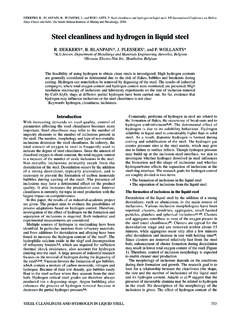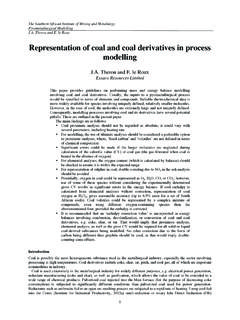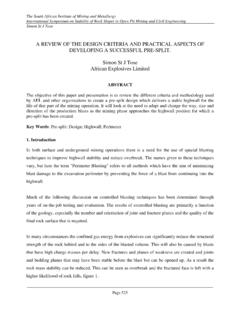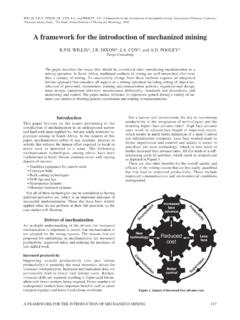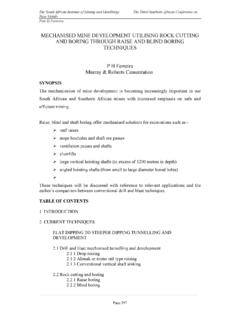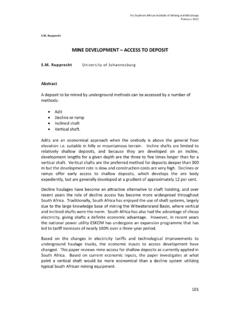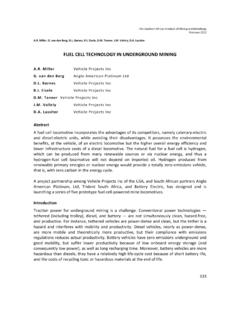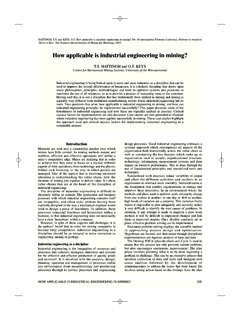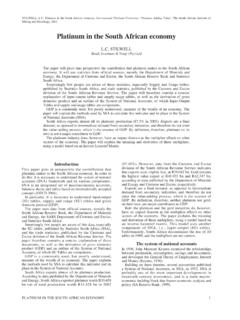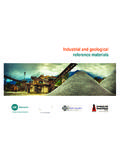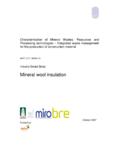Transcription of MILLS, K.C., FOX, A.B., THACKRAY, R.P. and LI, Z. The ...
1 THE PERFORMANCE AND PROPERTIES OF MOULD FLUXES713 IntroductionMould fluxes have a major role in the continuous casting ofsteel. The powders are fed onto the top of the molten metalsurface, whereupon they form first a sinter layer, then amushy layer, and eventually form a liquid flux pool (Figure1a). Liquid slag from the molten pool infiltrates into themould/strand channel and lubricates the newly-formed steelshell. However, most of the first liquid entering the channelfreezes against the water-cooled, copper mould and forms aglassy, solid slag film (typically ca. 2 mm thick1). A thinliquid slag film (ca. mm thick) moves with the steelshell and provides liquid lubrication to the shell. In time,the glassy slag may partially crystallize. The solid slag layeris usually considered to stay attached to the mould wall or,if it does move, it must be much slower than the velocity ofthe shell.
2 The mould is oscillated to prevent the shell fromsticking to the mould. The horizontal heat transfer iscontrolled by both the thickness and the nature of the solidslag layer. Thus, in summary, the liquid slag layer controlsthe lubrication and the solid slag layer controls thehorizontal heat transfer. It is generally accepted that the depth of the molten slagpool (dpool) should exceed the stroke length to ensure goodslag infiltration ( lubrication of the steel shell) andfrequently a depth of >10 mm2,3is recommended. Thedepth of the molten pool affects both the amount of liquidslag infiltrating into the mould / strand channel2,3and thenumber of inclusions transferred from the steel to themolten role of the slag in continuous casting is to: Protect the meniscus of the steel from oxidation Provide thermal insulation to prevent the steel surfacefrom freezing Provide liquid slag to lubricate the strand Provide the optimum level of horizontal heat transferfor the steel grade being cast Absorb inclusions from the of these functions are important but in routinepractice it is the lubrication and the horizontal heat transfer,that are the most important.
3 The principal factors affectingflux performance are: Casting conditions (casting speed, Vc, oscillationcharacteristics) Steel grade and mould dimensions Mould level control (which can lead to depressionsetc.) Metal flow, since turbulent flow can lead to severalproblems gas and slag will see that efficient execution of the tasks listedabove requires the optimization of the physical properties ofthe fluxes are usually made up of about 70% (CaOand SiO2), 0 6% MgO, 2 6% Al2O3, 2 10% Na2O (+K2O), 0 10% F with varying additions of TiO2, ZrO2, B2O3Li2O, and MnO. The basicity, (%CaO / %SiO2) lies in therange to Carbon particles in the form of cokebreeze, carbon black and graphite are added (2 20%) to (i)control the melting rate and (ii) to form a reducingatmosphere of CO (g) in the upper mould to protect themetal from oxidation.
4 Carbon particles are non-wetting toslag and thus slag globules are prevented fromagglomerating by carbon particles until the latter areconsumed by oxidation; this is the mechanism for thecontrol of melting properties and functions of mould fluxLubrication and powder consumptionThe liquid mould flux lubricates the steel strand. It isimportant that there is liquid lubrication throughout thestrand since problems (such as star cracking of the steel)can occur if the flux crystallizes completely in the lowerhalf of the mould and liquid lubrication is lost5,6. For thefully liquid flux, assuming Newtonian behaviour the liquidfriction (Fl) is given by Equation [1] where Vmis thevelocity of the mould, and Ais the area of the mould.
5 It canbe seen that the friction decreases as the viscosity ( )decreases and the liquid flux film thickness (dl) increases. Fl= A ( Vm- Vm) / dl[1]Powder consumption, Qsprovides a measure of thelubrication supplied and it is very dependent upon mouldsize since the friction increases as the distance from thecorner increases7 Thus frictional forces are much larger inslabs > blooms > billets and increase with increasingMILLS, , FOX, , THACKRAY, and LI, Z. The performance and properties of mould fluxes. VII International Conference on Molten SlagsFluxes and Salts,The South African Institute of Mining and Metallurgy, performance and properties of mould MILLS, FOX, THACKRAY and Z. LIDepartment of Materials, Imperial College London, United KingdomThe role of mould fluxes in continuous casting is reviewed.
6 The main functions of the flux aredescribed and the importance of the flux in providing lubrication and the right level of heattransfer between the shell and the mould is described. The major problems of longitudinal,transverse and star cracking, gas and slag entrapment and deep oscillation marks in the steelproduct and sticker breakouts are analysed. The important physical properties of the flux incombating these various problems are identified. Physical property data for the fluxes are SLAGS FLUXES AND SALTS714viscosity of the liquid. Powder consumption (Qt) is usuallymeasured as kg flux (tonne steel)-1. However, Qtcan beconverted to Qswith units of kg flux m-2(of mould) usingEquation [2].Qs= f*.Qt. R = dl [2]where f* is the fraction of powder producing slag, thedensity of the liquid slag and Ris the (surface area tovolume ratio of the mould) and is given by 2(w + t)/wt,where wand tare the width and thickness of the mould,respectively.
7 The friction forces increase with increasingdistance from the corner so, consequently, more lubrication( higher Qs) is required for slabs > blooms > billets. Inadequate powder consumption has been reported tolead to a variety of defects and problems namely, (i)longitudinal cracking, (ii) sticker breakouts (which arealways related to lack of lubrication), (iii) deep oscillationmarks, (iv) transverse corner cracking, (v) off-cornercracking, and (vi) the formation of powder consumption is made up of severalcontributions. Most workers identify two contributions tothe powder consumption (i) that used to lubricate themould, Qluband (ii) that trapped in the oscillation marks,Qom. Three mathematical models have been reported8-10which allow the calculation of Qombut it has been shownrecently11, that they usually overestimate Qomby aconsiderable amount.
8 Itoyama17reported Qlubcontainedcontributions from (i) flow emanating from the molten pool(ii) flow between parallel plates (mould and strand), and(iii) arising from the oscillation of the mould. Severalempirical rules have been proposed12 20for the calculationof Qsfrom values for various casting parameters (casting,speed, flux viscosity, etc.). Recently, a statistical analysis ofplant data for Qsshowed that the following parameters hadstatistical significance, slag viscosity, casting speed,oscillation frequency (f) and stroke length and the break(Tbrsee Break solidification below) or solidificationtemperature (Tsol)21. From the viewpoint of the mould flux,powder consumption increases as the flux viscosity andbreak temperature both melting rate (MR) must meet the demand for liquidslag ( the powder consumption).
9 It is controlledprimarily by (i) the amount of free carbon and (ii) theparticle size of the carbon. The melting rate can becalculated from the following + [3]Horizontal heat flux, qhorHorizontal heat transfer is a complex process involving twomechanisms, namely, lattice or phonon conductivity (kc)and radiation conductivity (kR). Radiation conductivityinvolves absorption and re-emission of radiated energy andcan be the dominant conduction mechanism in glassymaterials at high temperatures. The radiation conductivitycan be calculated from Equation [4] for optically thickconditions (defined as d >3) where = absorptioncoefficient, d= thickness, = Stefan Boltzmann constant, n= refractive index (usually around ), and Tis thethermodynamic temperature (K)kR= 16 n2T3/ 3 [4]However, kRcan be significantly decreased by the presencein the slag film of:(i) crystallites that scatter the radiation (extinctioncoefficient E= + Swhere Sis the scatteringcoefficient and Eshould be used for solids)(ii) transition metal oxides that absorb the radiation has been estimated that kR= 10 30% kc22 24for heattransfer across slag films formed during industrial slabcasting.
10 However, it may be much more significant inglassy slag films formed using high-viscosity fluxes forbillet overall resistance to thermal transfer (R*total)between shell and mould can be regarded as a series ofresistances as shown in Figure 2 and Equation [5].R*total= R*Cu/sl+ (d/k)l+(d/k)gl+ (d/k)cry[5]where R*Cu/slis the interfacial resistance and subscripts l, gland crydenote the liquid, glass and crystalline layers,respectively. Radiation conductivity can be taken intoaccount as a parallel resistance24. The largest terms inEquation [5] affecting (R*total) are (i) R*Cu/sland (ii) thethickness of the solid slag film ie dsolid= dgl+ interfacial resistance R*Cu/slwas found25,26toincrease with (i) increasing solid slag thickness, dsolidand(ii) increasing crystallinity (Figure 3), and (iii) had valuesFigure 1.
